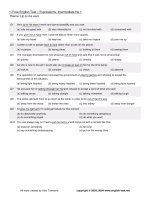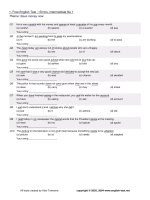Intermediate macroeconomics chapt10
Bạn đang xem bản rút gọn của tài liệu. Xem và tải ngay bản đầy đủ của tài liệu tại đây (335.82 KB, 22 trang )
Chapter 10: Aggregate
Demand I
The IS-LM Model
A short-run macroeconomic model which takes the price
level constant and shows how changes in the level of
Aggregate Demand cause changes in income.
The IS curve: The Keynesian Cross Theory
The LM curve: The Liquidity Preference Theory
Shift in Aggregate Demand
An increase in the level AD increases
the level of income, given the price level.
Price level
P
SRAS
AD3
AD2
AD1
Y1
Y2
Y3
Output, Income
The Keynesian Cross
Equilibrium in the product market:
Planned Expenditures: E = C(Y-T) + I + G
Actual Expenditures: Y
Aggregate Equilibrium: Y = C(Y-T) + I + G
Total income = Total planned expenditures
Aggregate Equilibrium
Actual Expenditure: Y = E
E
Planned Expenditure:
E=C+I+G
Keynesian Cross
Increase inventories
Y2
Y
Reduce inventories
Y1
Y
Adjustment to Equilibrium
Y1> Y indicates an excess supply of goods in the market.
So, businesses accumulate inventories to reduce Y1 to Y
Y2
Effect of Stabilization Policy
A government policy of changing planned expenditure, C,
I, or G, would shift the Planned Expenditure line to
increase the level of income.
The increase in income is subject to a multiplier effect as
spending by consumers receiving the new income, creates
income for other consumers
Effect of Government Spending Policy
Y=E
E = C + I + G2
E
B
E = C + I + G1
ΔG
A
ΔY
Y1
Y2
Y
Government Spending Multiplier
ΔG = Increase in government purchases
ΔY = Increase in income
Multiplier effect: ΔY / ΔG = 1 / (1 – MPC)
Example, MPC = 0.6, Spending Multiplier = 2.50; Any $1
increase in G creates an additional $2.50 of income
Effect of Government Tax Policy
Y=E
E
B
ΔC
E = C2 + I + G
E = C 1+ I + G
A
ΔY
Y1
Y2
Y
Government Tax Multiplier
ΔT = Decrease in income taxes
ΔC = Increase in consumption = -MPC * ΔT
ΔY = Increase in income
Multiplier effect: ΔY / ΔT = -MPC / (1 – MPC)
Example, MPC = 0.6, Tax Multiplier = -1.50; Any $1
decrease in T creates an additional $1.50 of income
Derivation of IS Curve
IS shows level of income and interest rate that bring about
equilibrium to the product market
Assume an initial income level and interest rate. An
increases in interest rate reduces planned investment.
Then, the Planned Expenditure line shifts down, causing
income to decline.
IS Curve
Interest rate
r2
IS shows pairs of income and interest rate
such as (Y1, r1) and (Y2, r2) that bring
about equilibrium in the product market.
The higher the interest rate, the lower the
level of income.
B
A
r1
Y2
Y1
Income
Shift of IS Curve
Interest rate
An increase in planned expenditure (C, I, or G)
causes the IS to increase, hence increasing the
level of income through the multiplier effect.
IS2
IS1
Y1
Y2
Income
Theory of Liquidity Preference
Equilibrium in the money market
Demand for money: (M/P)d = L(r,Y)
Money supply: (M/P)s = M/P
Equilibrium: M/P = L(r, Y)
Money Market Equilibrium
r
_
M/P
r1
L(r, Y)
M/P
Derivation of LM Curve
An increase in the level of income causes the demand for
money to increase. As a result of a higher demand for
money, the interest rate goes up
The higher the level of income, the higher is the rate of
interest
Derivation of LM Curve
LM shows pairs of income and interest rate such as
(Y1, r1) and (Y2, r2) that bring bout equilibrium
in the money market.
r
_
LM
M/P
r2
r2
r1
r1
L(r, Y2)
L(r, Y1)
M/P
Y1
Y2
Shift in LM Curve
r
M1/P
LM1
M2/P
LM2
r1
r1
r2
r2
L(r, Y)
M/P
An increase in the money supply, lowers the
interest rate, making the LM curve to increase.
Y
Aggregate Equilibrium
Aggregate equilibrium is achieved when IS = LM
IS: Y = C(Y - T) + I(r) + G
LM: M/P = L(r, Y)
Aggregate Equilibrium
Interest rate
LM
r
IS
Y
Income
Theory of Short-Run Fluctuations
Keynesian
Cross
AD Curve
IS Curve
AD-AS
Model
IS-LM
Model
Theory of
Liquidity
Preference
LM Curve
AS Curve
Short-run
Fluctuations:
Income
Interest
Rate









